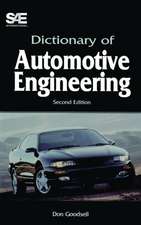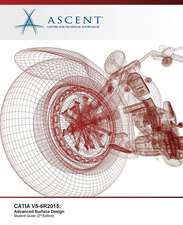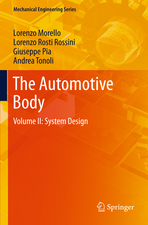Internal Combustion Engine Fundamentals Second Edition
Autor John Heywooden Limba Engleză Hardback – 31 mai 2018
Preț: 859.12 lei
Preț vechi: 1232.60 lei
-30% Nou
164.39€ • 171.64$ • 136.06£
Carte tipărită la comandă
Livrare economică 04-09 aprilie
Livrare express 28 februarie-06 martie pentru 172.28 lei
Specificații
ISBN-10: 1260116107
Pagini: 904
Dimensiuni: 213 x 262 x 48 mm
Greutate: 2.02 kg
Ediția:2
Editura: McGraw Hill Education
Colecția McGraw-Hill
Locul publicării:United States
Cuprins
Commonly Used Symbols, Subscripts, and Abbreviations
CHAPTER 1 Engine Types and Their Operation
1.1 Introduction and Historical Perspective
1.2 Engine Classifications
1.3 Engine Operating Cycles
1.4 Engine Components
1.5 Multicylinder Engines
1.6 Spark-Ignition Engine Operation
1.7 Different Types of Four-Stroke SI Engines
1.7.1 Spark-Ignition Engines with Port Fuel Injection
1.7.2 SI Engines for Hybrid Electric Vehicles
1.7.3 Boosted SI Engines
1.7.4 Direct-Injection SI Engines
1.7.5 Prechamber SI Engines
1.7.6 Rotary Engines
1.8 Compression-Ignition Engine Operation
1.9 Different Types of Diesel Engines
1.10 Two-Stroke Cycle Engine Operation
1.11 Fuels
1.11.1 Gasoline and Diesel
1.11.2 Alternative Fuels
Problems
References
CHAPTER 2 Engine Design and Operating Parameters
2.1 Important Engine Characteristics
2.2 Geometrical Relationships for Reciprocating Engines
2.3 Forces in Reciprocating Mechanism
2.4 Brake Torque and Power
2.5 Indicated Work per Cycle
2.6 Mechanical Efficiency
2.7 Mean Effective Pressure
2.8 Specific Fuel Consumption and Efficiency
2.9 Air/Fuel and Fuel/Air Ratios
2.10 Volumetric Efficiency
2.11 Specific Power, Specific Weight, and Specific Volume
2.12 Correction Factors for Power and Volumetric Efficiency
2.13 Specific Emissions and Emissions Index
2.14 Relationships between Performance Parameters
2.15 Engine Design and Performance Data
2.16 Vehicle Power Requirements
Problems
References
CHAPTER 3 Thermochemistry of Fuel-Air Mixtures
3.1 Characterization of Flames
3.2 Ideal Gas Model
3.3 Composition of Air and Fuels
3.4 Combustion Stoichiometry
3.5 The First Law of Thermodynamics and Combustion
3.5.1 Energy and Enthalpy Balances
3.5.2 Enthalpies of Formation
3.5.3 Heating Values
3.5.4 Adiabatic Combustion Processes
3.5.5 Combustion Efficiency of an Internal Combustion Engine
3.6 The Second Law of Thermodynamics Applied to Combustion
3.6.1 Entropy
3.6.2 Maximum Work from an Internal Combustion Engine and Efficiency
3.7 Chemically Reacting Gas Mixtures
3.7.1 Chemical Equilibrium
3.7.2 Chemical Reaction Rates
Problems
References
CHAPTER 4 Properties of Working Fluids
4.1 Introduction
4.2 Unburned Mixture Composition
4.3 Gas Property Relationships
4.4 A Simple Analytic Ideal Gas Model
4.5 Thermodynamic Property Charts
4.5.1 Unburned Mixture Charts
4.5.2 Burned Mixture Charts
4.5.3 Relation between Unburned and Burned Mixture Charts
4.6 Tables of Properties and Composition
4.7 Computer Routines for Property and Composition Calculations
4.7.1 Unburned Mixtures
4.7.2 Burned Mixtures
4.8 Transport Properties
4.9 Exhaust Gas Composition
4.9.1 Species Concentration Data
4.9.2 Equivalence Ratio Determination from Exhaust Gas Constituents
4.9.3 Effects of Fuel/Air Ratio Nonuniformity
4.9.4 Combustion Inefficiency
Problems
References
CHAPTER 5 Ideal Models of Engine Cycles
5.1 Introduction
5.2 Ideal Models of Engine Processes
5.3 Thermodynamic Relations for Engine Processes
5.4 Cycle Analysis with Ideal Gas Working Fluid with cv and cp Constant
5.4.1 Constant-Volume Cycle
5.4.2 Limited- and Constant-Pressure Cycles
5.4.3 Cycle Comparison
5.5 Fuel-Air Cycle Analysis
5.5.1 SI Engine Cycle Simulation
5.5.2 CI Engine Cycle Simulation
5.5.3 Results of Cycle Calculations
5.6 Overexpanded Engine Cycles
5.7 Availability Analysis of Engine Processes
5.7.1 Availability Relationships
5.7.2 Entropy Changes in Ideal Cycles
5.7.3 Availability Analysis of Ideal Cycles
5.7.4 Effect of Equivalence Ratio
5.8 Comparison with Real Engine Cycles
Problems
References
CHAPTER 6 Gas Exchange Processes
6.1 Intake and Exhaust Processes in the Four-Stroke Cycle
6.2 Volumetric Efficiency
6.2.1 Quasi-Static Effects
6.2.2 Intake and Exhaust Flow Resistances
6.2.3 Intake and In-Cylinder Heat Transfer
6.2.4 Intake Valve Timing Effects
6.2.5 Airflow Choking at Intake Valve
6.2.6 Intake and Exhaust Tuning
6.2.7 Combined Effects: Naturally-Aspirated Engines
6.2.8 Effects of Turbocharging
6.3 Flow through Valves and Ports
6.3.1 Valve and Port Geometry and Operation
6.3.2 Flow Rates and Discharge Coefficients
6.3.3 Variable Valve Timing and Control
6.4 Residual Gas Fraction
6.5 Exhaust Gas Flow Rate and Temperature Variation
6.6 Scavenging in Two-Stroke Cycle Engines
6.6.1 Two-Stroke Engine Configurations
6.6.2 Scavenging Parameters and Models
6.6.3 Actual Scavenging Processes
6.7 Flow through Two-Stroke Engine Ports
6.8 Supercharging and Turbocharging
6.8.1 Methods of Power Boosting
6.8.2 Basic Relationships
6.8.3 Compressors
6.8.4 Turbines
6.8.5 Compressor, Engine, Turbine Matching
6.8.6 Wave-Compression Devices
Problems
References
CHAPTER 7 Mixture Preparation in SI Engines
7.1 Spark-Ignition Engine Mixture Requirements
7.2 Fuel Metering Overview
7.2.1 Mixture Formation Approaches
7.2.2 Relevant Characteristics of Fuels
7.3 Central (Throttle-Body) Fuel Injection
7.4 Port (Multipoint) Fuel Injection
7.4.1 System Layout, Components, and Function
7.4.2 Fuel Spray Behavior
7.4.3 Reverse Flow Impacts
7.5 Air Flow Phenomena
7.5.1 Flow Past the Throttle Plate
7.5.2 Flow in Intake Manifolds
7.5.3 Air Flow Models
7.6 Fuel Flow Phenomena: Port Fuel Injection
7.6.1 Liquid Fuel Behavior
7.6.2 Transients: Fuel-Film Models
7.7 Direct Fuel Injection
7.7.1 Overview of Direct-Injection Approaches
7.7.2 DI Mixture Preparation Processes
7.7.3 DI Engine System and Components
7.8 Exhaust Gas Oxygen Sensors
7.9 Fuel Supply Systems
7.10 Liquid Petroleum Gas and Natural Gas
Problems
References
CHAPTER 8 Charge Motion within the Cylinder
8.1 Intake-Generated Flows
8.2 Mean Velocity and Turbulence Characteristics
8.2.1 Definitions of Relevant Parameters
8.2.2 Application to Engine Velocity Data
8.3 Swirl
8.3.1 Swirl Measurement
8.3.2 Swirl Generation during Induction
8.3.3 Swirl Modification within the Cylinder
8.4 Tumble
8.5 Piston-Generated Flows: Squish
8.6 Swirl, Tumble, Squish Flow Interactions
8.7 Prechamber Engine Flows
8.8 Crevice Flows and Blowby
8.9 Flows Generated by Piston Cylinder-Wall Interaction
Problems
References
CHAPTER 9 Combustion in Spark-Ignition Engines
9.1 Essential Features of Process
9.1.1 Combustion Fundamentals
9.1.2 SI Engine Combustion Process
9.2 Thermodynamics of SI Engine Combustion
9.2.1 Burned and Unburned Mixture States
9.2.2 Analysis of Cylinder Pressure Data
9.2.3 Combustion Process Characterization
9.3 Flame Structure and Speed
9.3.1 Overall Observations
9.3.2 Flame Structure
9.3.3 Laminar Burning Speeds
9.3.4 Flame Propagation Relations
9.3.5 Combustion with Direct Fuel Injection
9.4 Cyclic Variations in Combustion, Partial Burning, and Misfire
9.4.1 Observations and Definitions
9.4.2 Causes of Cycle-by-Cycle and Cylinder-to-Cylinder Variations
9.4.3 Partial Burning, Misfire, and Engine Stability
9.5 Spark Ignition
9.5.1 Ignition Fundamentals
9.5.2 Standard Ignition Systems
9.5.3 Alternative Ignition Approaches
9.6 Abnormal Combustion: Spontaneous Ignition and Knock
9.6.1 Description of Phenomena
9.6.2 Knock Fundamentals
9.6.3 Fuel Factors
9.6.4 Sporadic Preignition and Knock
9.6.5 Knock Suppression
Problems
References
CHAPTER 10 Combustion in Compression-Ignition Engines
10.1 Essential Features of Process
10.2 Types of Diesel Combustion Systems
10.2.1 Direct-Injection Systems
10.2.2 Other Diesel Combustion Systems
10.2.3 Comparison of Different Combustion Systems
10.3 Diesel Engine Combustion
10.3.1 Optical Studies of Diesel Combustion
10.3.2 Combustion in Direct-Injection Multi-Spray Systems
10.3.3 Heat-Release-Rate Analysis
10.3.4 Conceptual Model of DI Diesel Combustion
10.4 Fuel Spray Behavior
10.4.1 Fuel Injection
10.4.2 Overall Spray Structure
10.4.3 Atomization and Spray Development
10.4.4 Spray Penetration
10.4.5 Droplet Size Distribution
10.4.6 Spray Evaporation
10.5 Ignition Delay
10.5.1 Definition and Discussion
10.5.2 Fuel Ignition Quality
10.5.3 Autoignition and Premixed Burn
10.5.4 Physical Factors Affecting Ignition Delay
10.5.5 Effect of Fuel Properties
10.5.6 Correlations for Ignition Delay in Engines
10.6 Mixing-Controlled Combustion
10.6.1 Background
10.6.2 Spray and Flame Structure
10.6.3 Fuel-Air Mixing and Burning Rates
10.7 Alternative Compression-Ignition Combustion Approaches
10.7.1 Multiple-Injection Diesel Combustion
10.7.2 Advanced Compression-Ignition Combustion Concepts
Problems
References
CHAPTER 11 Pollutant Formation and Control
11.1 Nature and Extent of Problem
11.2 Nitrogen Oxides
11.2.1 Kinetics of NO Formation
11.2.2 Formation of NO2
11.2.3 NO Formation in Spark-Ignition Engines
11.2.4 NOx Formation in Compression-Ignition Engines
11.3 Carbon Monoxide
11.4 Hydrocarbon Emissions
11.4.1 Background
11.4.2 Flame Quenching and Oxidation Fundamentals
11.4.3 HC Emissions from Spark-Ignition Engines
11.4.4 Hydrocarbon Emission Mechanisms in Diesel Engine
11.5 Particulate Emissions
11.5.1 Spark-Ignition Engine Particulates
11.5.2 Characteristics of Diesel Particulates
11.5.3 Particulate Distribution within the Cylinder
11.5.4 Soot Formation Fundamentals
11.5.5 Soot Oxidation
11.5.6 Adsorption and Condensation
11.6 Exhaust Gas Treatment
11.6.1 Available Options
11.6.2 Catalyst Fundamentals
11.6.3 Catalytic Converters
11.6.4 Particulate Filters or Traps
11.6.5 Exhaust Treatment Systems
Problems
References
CHAPTER 12 Engine Heat Transfer
12.1 Importance of Heat Transfer
12.2 Modes of Heat Transfer
12.2.1 Conduction
12.2.2 Convection
12.2.3 Radiation
12.2.4 Overall Heat-Transfer Process
12.3 Heat Transfer and Engine Energy Balance
12.4 Convective Heat Transfer
12.4.1 Dimensional Analysis
12.4.2 Correlations for Time-Averaged Heat Flux
12.4.3 Correlations for Instantaneous Spatial Average Coefficients
12.4.4 Correlations for Instantaneous Local Coefficients
12.4.5 Exhaust and Intake System Heat Transfer
12.5 Radiative Heat Transfer
12.5.1 Radiation from Gases
12.5.2 Flame Radiation
12.6 Measurements of Instantaneous Heat-Transfer Rates
12.6.1 Measurement Methods
12.6.2 Spark-Ignition Engine Measurements
12.6.3 Diesel Engine Measurements
12.6.4 Evaluation of Heat-Transfer Correlations
12.6.5 Boundary-Layer Behavior
12.7 Thermal Loading and Component Temperatures
12.7.1 Effect of Engine Variables
12.7.2 Component Temperature Distributions
12.7.3 Engine Warm-Up
Problems
References
CHAPTER 13 Engine Friction and Lubrication
13.1 Background
13.2 Definitions
13.3 Friction Fundamentals
13.3.1 Lubricated Friction
13.3.2 Turbulent Dissipation
13.3.3 Total Friction
13.4 Measurement Methods
13.5 Engine Friction Data
13.5.1 SI Engines
13.5.2 Diesel Engines
13.6 Mechanical Friction Components
13.6.1 Motored Engine Breakdown Tests
13.6.2 Engine Lubrication System
13.6.3 Piston Assembly Friction and Lubrication
13.6.4 Crankshaft Friction
13.6.5 Valvetrain Friction
13.7 Pumping Friction
13.8 Accessory Power Requirements
13.9 Engine Friction Modeling
13.10 Oil Consumption
13.10.1 Oil Consumption Context
13.10.2 Oil Transport into the Cylinder
13.10.3 Oil Evaporation
13.10.4 Blowby and Oil Entrainment
13.11 Lubricants
Problems
References
CHAPTER 14 Modeling Real Engine Flow and Combustion Processes
14.1 Purpose and Classification of Models
14.2 Governing Equations for an Open Thermodynamic System
14.2.1 Conservation of Mass
14.2.2 Conservation of Energy
14.3 Intake and Exhaust Flow Models
14.3.1 Background
14.3.2 Quasi-Steady Flow Models
14.3.3 Filling and Emptying Methods
14.3.4 Gas Dynamic Models
14.4 Thermodynamic-Based In-Cylinder Models
14.4.1 Background and Overall Model Structure
14.4.2 Spark-Ignition Engine Models
14.4.3 Direct-Injection Engine Models
14.4.4 Prechamber Engine Models
14.4.5 Multi-Cylinder and Complex Engine System Models
14.4.6 Second-Law Analysis of Engine Processes
14.5 Fluid-Mechanic-Based Multi-Dimensional Models
14.5.1 Basic Approach and Governing Equations
14.5.2 Turbulence Models
14.5.3 Numerical Methodology
14.5.4 Flow Field Predictions
14.5.5 Fuel Spray Modeling
14.5.6 Combustion Modeling
References
CHAPTER 15 Engine Operating Characteristics
15.1 Engine Design Objectives
15.2 Engine Performance
15.2.1 Basic Characteristics of SI and Diesel Engines
15.2.2 Characterizing Engine Performance
15.2.3 Torque, Power, and Mean Effective Pressure
15.2.4 Engine Performance Maps
15.3 Operating Variables That Affect SI Engine Performance, Efficiency, and Emissions
15.3.1 Spark Timing
15.3.2 Mixture Composition
15.3.3 Load and Speed
15.3.4 Compression Ratio
15.4 SI Engine Combustion System Design
15.4.1 Objectives and Options
15.4.2 Factors That Control Combustion
15.4.3 Factors That Control Performance
15.4.4 Chamber Octane Requirement
15.4.5 SI Engine Emissions
15.4.6 Optimization
15.5 Variables That Affect Diesel Engine Performance, Efficiency, and Emissions
15.5.1 Load and Speed
15.5.2 Combustion-System Design
15.5.3 Fuel Injection and EGR
15.5.4 Overall System Behavior
15.6 Two-Stroke Cycle Engines
15.6.1 Performance Parameters
15.6.2 Two-Stroke Gasoline SI Engines
15.6.3 Two-Stroke Cycle CI Engines
15.7 Noise, Vibration, and Harshness
15.7.1 Engine Noise
15.7.2 Reciprocating Mechanism Dynamics
15.7.3 Engine Balancing
15.8 Engine Performance and Fuels Summary
Problems
References
APPENDIX A Unit Conversion Factors
APPENDIX B Ideal Gas Relationships
B.1 Ideal Gas Law
B.2 The Mole
B.3 Thermodynamic Properties
B.4 Mixtures of Ideal Gases
APPENDIX C Equations for Fluid Flow through a Restriction
C.1 Liquid Flow
C.2 Gas Flow
References
APPENDIX D Data on Working Fluids
Index























